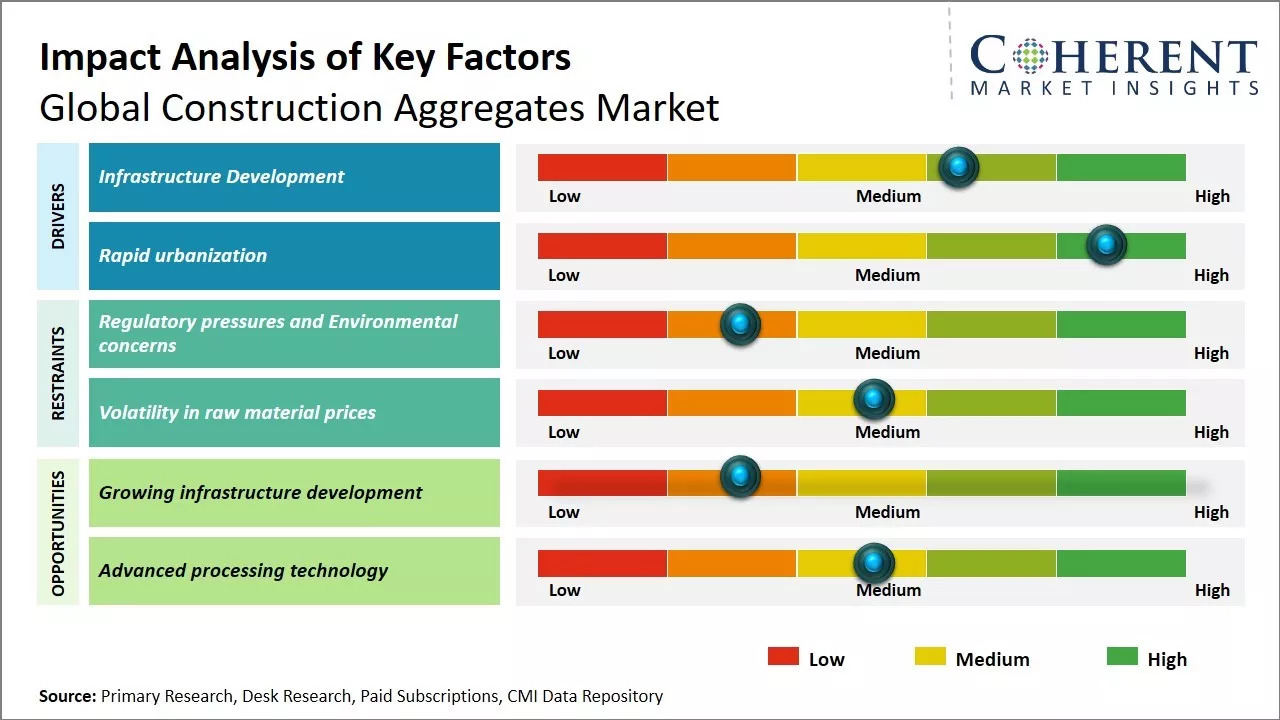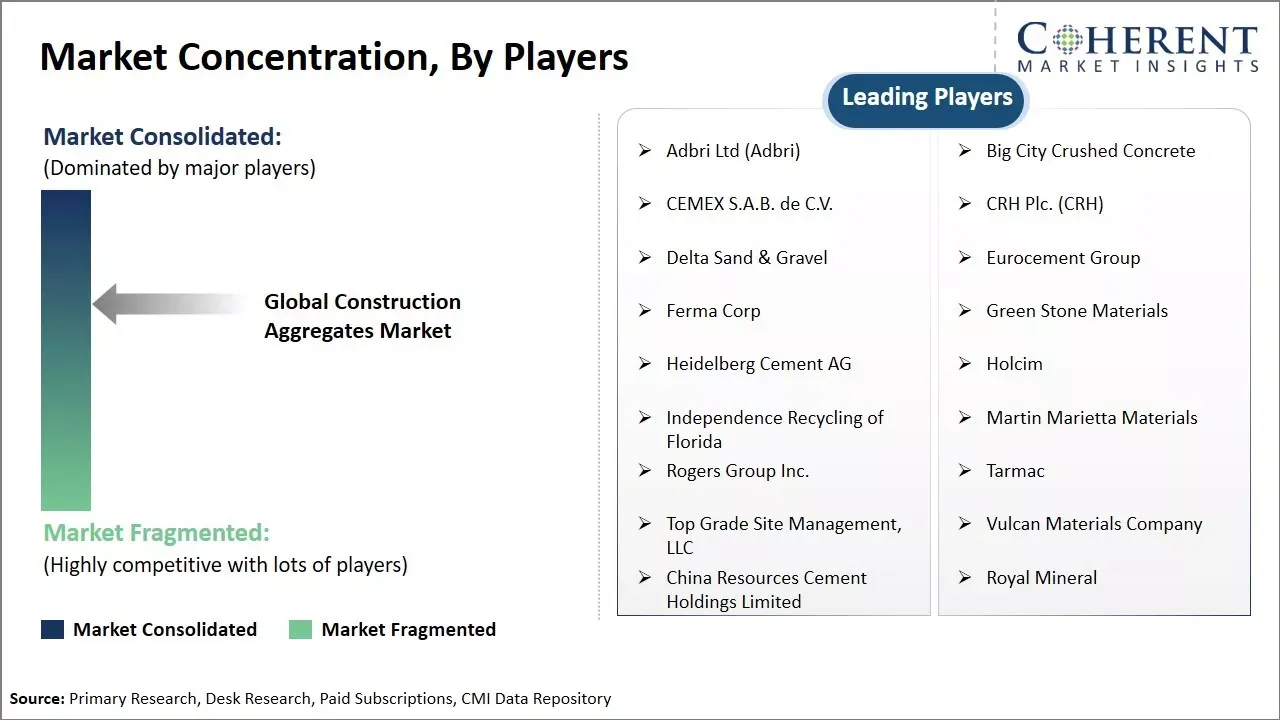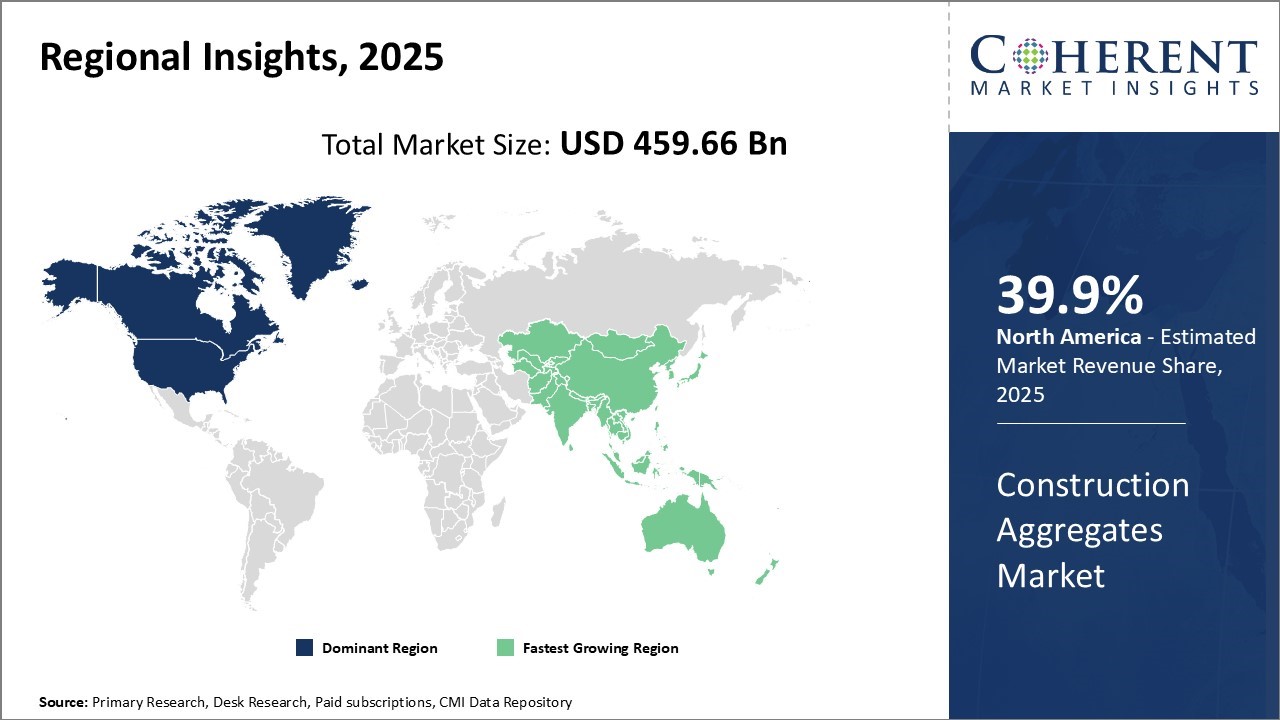The construction aggregates market is estimated to be valued at USD 459.66 Bn in 2025 and is expected to reach USD 647.22 Bn by 2032, exhibiting a compound annual growth rate (CAGR) of 5% from 2025 to 2032.

To learn more about this report, Download Free Sample
Rapid urbanization and increasing construction of roads and buildings around the world is boosting the demand for crushed stone, sand, and gravel. The market is expected to witness growth due to ongoing investments in infrastructure development globally. Many countries are focused on improving connectivity through road and rail projects. Mega construction projects related to bridges, dams, and airports will continue to need huge volumes of aggregates.
However, environmental concerns around illegally sourced materials could hamper supply if not addressed properly.

To learn more about this report, Download Free Sample
|
Current Events |
Description and its impact |
|
Environmental Regulations and Sustainability Shifts |
|
|
Inflation and Supply Chain Volatility |
|
Uncover macros and micros vetted on 75+ parameters: Get instant access to report
Global construction aggregates market is expected to witness significant growth due to increasing large scale infrastructure development activities worldwide. There is a major focus on developing roads, highways, bridges, rail networks and other transportation infrastructure in most countries to facilitate better movement of goods and people. Both developed and developing nations are spending big amount on modernizing and expanding their infrastructure to boost economic growth.
According to the American Society of Civil Engineers’ Bridging the Gap report (May 2024), the Infrastructure Investment and Jobs Act and the Inflation Reduction Act are expected to contribute an estimated USD 580 billion in new infrastructure investments from 2022 to 2026—a significant and foundational step in narrowing the nation’s infrastructure funding shortfall.
The world is undergoing rapid urbanization with more people migrating to cities each year in search of better living standards and employment opportunities. Construction aggregates, which include crushed stone, sand, and gravel, form the basic raw materials for concrete, asphalt, and other construction applications.
For instance, as per a study by the World Population Review, global urbanization stood at 57.5% in 2023, on pace for an urbanization rate of 1.75% from 2020-2025. Urbanization causes unique issues for both humans and the environment, particularly if a country’s population grows more quickly than its infrastructure.
In terms of product type, sand & gravel segment is estimated to contribute the 41.7% share of the global construction aggregates market in 2025, owing to its widespread infrastructure applications.
Sand and gravel consist of naturally occurring granular materials resulting from the natural disintegration of rock and stone. These are highly versatile building materials that can be easily obtained and processed near construction sites. A key factor driving the dominance of sand and gravel is the ongoing infrastructure development across major economies.
In terms of application, infrastructure segment is estimated to contribute 39.2% share of market due to infrastructure development applications. Mega infrastructure projects require huge volumes of aggregate materials for construction activities.
These include road and highway construction, rail networks, urban infrastructure like bridges and tunnels, energy production facilities, and large public buildings. Many nations are prioritizing infrastructure spending to boost economic growth, connectivity and urban development.
Construction aggregates management in clinical trials is being revolutionized by AI-powered solutions.

To learn more about this report, Download Free Sample
North America has firmly established itself as the dominant region in the global construction aggregates market. It is home to some of the largest construction aggregates producers in the world with estimated 39.9% market share in 2025.
For instance, in March 2025, Government of Canada partnered with Heidelberg Materials to drive cement industry decarbonization. Canada is supporting new technologies to reduce greenhouse gas (GHG) emissions from heavy industries like cement and concrete. The Honourable François‑Philippe Champagne, Minister of Innovation, Science and Industry, shared that the Innovation, Science and Economic Development Canada (ISED) is working with Heidelberg Materials to finalize negotiation on a contribution agreement regarding its Edmonton carbon capture, utilization and storage (CCUS) plant.
Asia Pacific region is poised to become the fastest growing construction aggregates market globally iovern the forecasted period. China remains the single largest country market, but other massive government infrastructure initiatives such as the Belt and Road project ensure huge aggregate requirements to build new roads, rails, and housing across the region.
For instance, according to data published by the World Bank, China’s economy grew at a robust rate of 5.0 percent in the first half of 2024, supported by consumer spending on services, exports, and investment in manufacturing and public infrastructure.
The U.S. construction aggregates market is primarily driven by massive infrastructure investments. With a renewed national focus on repairing roads, bridges, railways, and water systems, demand for crushed stone, gravel, and sand continues to surge. Additionally, rising residential and commercial real estate projects, especially in Sun Belt states, further amplify the consumption of aggregates.
For instance, according to the Trade Economics, in March 2025, new home construction in the U.S. fell by 11.4% compared to the previous month, dropping to an annual rate of 1.324 million homes — the lowest in four months. This was lower than the expected 1.42 million, mainly due to high prices, high mortgage rates, and low demand.
China remains the largest consumer of construction aggregates globally, driven by its continued investment in urban development, transportation infrastructure, and industrial zones. Despite a moderation in the real estate sector, projects linked to smart cities, green infrastructure, and Belt and Road Initiative (BRI) corridors continue to require enormous volumes of sand, gravel, and crushed stone. Additionally, the push toward sustainable construction is increasing the demand for recycled aggregates.
India’s market growth is fueled by ambitious government-led infrastructure initiatives such as PM Gati Shakti, Smart Cities Mission, and the Bharatmala road development program. Rapid urbanization, a growing middle class, and robust public investments in metro rail, affordable housing, and logistics corridors are significantly expanding aggregate consumption.
For instance, according to the Press Information Bureau, the total infrastructure investment in India has significantly increased, with public and private sector contributions shaping the growth trajectory. India's total infrastructure spending has grown exponentially, with budget allocations rising to INR 10 lakh crore in 2023-24.
Germany’s aggregates market is underpinned by investments in transport modernization, renewable energy infrastructure, and climate-resilient urban development. Projects like the Ahr Valley flood reconstruction and expansion of onshore wind farms and solar installations are driving material needs. Moreover, strict environmental and land-use regulations are pushing innovation in recycled aggregates and resource-efficient extraction, making sustainability a key driver in the German market landscape.
| Report Coverage | Details | ||
|---|---|---|---|
| Base Year: | 2024 | Market Size in 2025: | USD 459.66 Bn |
| Historical Data for: | 2020 To 2024 | Forecast Period: | 2025 To 2032 |
| Forecast Period 2025 to 2032 CAGR: | 5% | 2032 Value Projection: | USD 647.22 Bn |
| Geographies covered: |
|
||
| Segments covered: |
|
||
| Companies covered: |
Adbri Ltd (Adbri), Big City Crushed Concrete, CEMEX S.A.B. de C.V., CRH Plc. (CRH), Delta Sand & Gravel, Eurocement Group, Ferma Corp, Green Stone Materials, Heidelberg Cement AG, Holcim, Independence Recycling of Florida, Martin Marietta Materials, Rogers Group Inc., Tarmac, Top Grade Site Management, LLC, Vulcan Materials Company, China Resources Cement Holdings Limited, and Royal Mineral |
||
| Growth Drivers: |
|
||
| Restraints & Challenges: |
|
||
Uncover macros and micros vetted on 75+ parameters: Get instant access to report
*Definition Global construction aggregates market consists of companies engaged in the mining and processing of construction aggregates materials such as sand, gravel, crushed stone, slag, recycled concrete, and geo synthetic aggregates. These materials are the basic ingredients used in buildings, roads, and other infrastructure projects. The processed construction aggregates are used as raw material inputs by concrete mixing plants, asphalt and concrete products manufacturing units, road construction companies, and other construction projects globally.
Share
Share
About Author
Yash Doshi is a Senior Management Consultant. He has 12+ years of experience in conducting research and handling consulting projects across verticals in APAC, EMEA, and the Americas.
He brings strong acumen in helping chemical companies navigate complex challenges and identify growth opportunities. He has deep expertise across the chemicals value chain, including commodity, specialty and fine chemicals, plastics and polymers, and petrochemicals. Yash is a sought-after speaker at industry conferences and contributes to various publications on topics related commodity, specialty and fine chemicals, plastics and polymers, and petrochemicals.
Missing comfort of reading report in your local language? Find your preferred language :
Transform your Strategy with Exclusive Trending Reports :
Frequently Asked Questions
Joining thousands of companies around the world committed to making the Excellent Business Solutions.
View All Our Clients